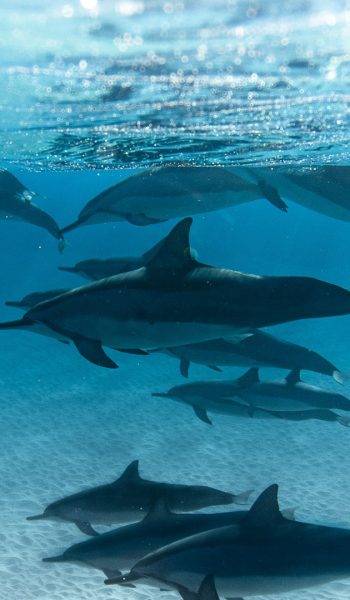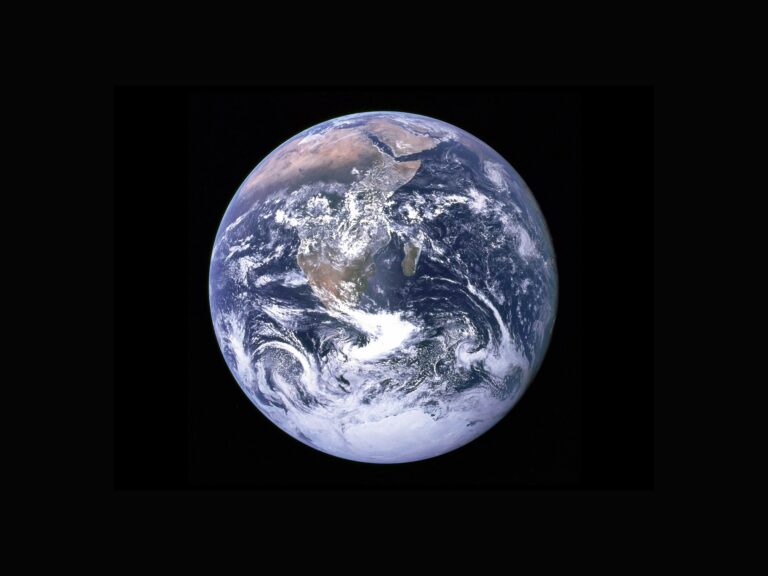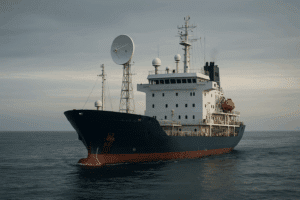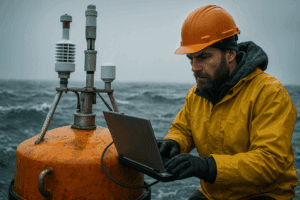At Sinay, we pride ourselves on supporting the European Union’s goal of a sustainable future as communicated through the 17 Sustainable Development Goals.
The United Nations 17 Sustainable Development Goals, in line with the 2030 Agenda for Sustainable Development, are “an urgent call for action by all countries, developing and developed, in a global partnership.” This call for action being peace and prosperity for all people and the planet from the present to the future. The goals focus on improving inequality regarding health, education, and the economy, with a large focus on helping to tackle climate change and preserve the oceans.
What are the 17 SDGs?
Your environmental monitoring at your fingertips!
Optimize your environmental monitoring, become smarter and more sustainable with a unified system that gathers all your environmental sensors & data in one place.

1. No Poverty
With a projected global poverty rate of 7% in 2030, the equivalent of 598,394,116 people, this UN goal aims to end poverty of all kinds.
SDG Goal 1 objectives include but are not limited to: end extreme poverty (those living on 1.25 dollars per day), reduce half the population living in poverty, implement protection systems, ensure equal rights to economic resources and basic services, reduce poverty-related vulnerability to climate change-induced extreme weather events, mobilize resources in developing countries, and create pro-poor and gender-sensitive policy frameworks by 2030.
The COVID-19 conflict set back poverty reduction progress.
2. Zero Hunger
As of 2020, 2.37 billion people are without food or unable to eat a healthy balanced diet, hence the goal of zero hunger.
“Zero Hunger” sets out to end hunger, achieve food security, improve nutrition, and promote sustainable agriculture. The global pandemic has only worsened global hunger, seeing as many as 161 million additional people will experience hunger as a result. Regarding women, 1/3 of those at a reproductive age experience Anaemia due to nutritional deficiencies.
SDG Goal 2 objectives include but are not limited to: end hunger, end all forms of malnutrition, double agricultural productivity and the income of small-scale food producers, bring resilience to agricultural practices and found sustainable food production systems, and maintain genetic food diversity.
3. Good Health and Well-Being
With a focus on increasing life expectancy and reducing common child and maternal diseases and killers, this goal targets ensuring healthy lives and promoting well-being for all ages. The global pandemic has only made health disparities more apparent, halting and even reducing life-expectancy progress.
SDG Goal 3 objectives include but are not limited to: reduce maternal mortality, end preventable newborn and child death, end multiple disease epidemics, reduce premature mortality, prevent and treat substance abuse, halt traffic-related deaths and injuries, ensure universal health coverage and access, reduce pollution and contamination deaths.
4. Quality Education
This goal ensures inclusive and equitable quality education and promotes lifelong learning for all. Sadly, COVID-19 reversed years of education gains, and many countries lack basic school infrastructure.
SDG Goal 4 objectives include but are not limited to: ensure free and quality primary and secondary education, give children access to early childhood development, ensure equal access for men and women to afford higher education choices, increase skills in youth, ensure gender equality, and promote sustainable development in education.
5. Gender Equality
SDG 5 targets to achieve gender equality and empower all women and girls. The percentage of women who work in national parliaments, local governments, and in managerial positions is still significantly less than that of men. Not to mention 1 in 3 women are subject to violence at least once since the age of 15, and child marriage is still highly present.
SDG Goal 5 objectives include but are not limited to: end discrimination against women, eliminate all forms of violence against women, eliminate harmful practices, value unpaid care and domestic work, ensure equal opportunities for leadership, ensure access to feminine health care, and ensure equal rights.
6. Clean Water and Sanitation
The availability and sustainable management of water and sanitation ensures safe water for drinking, sanitation, and hygiene, yet 2.3 billion people live in water-stressed countries.
SDG Goal 6 objectives include but are not limited to: provide equal universal access to safe drinking water, sanitation, and hygiene, reduce water pollution, increase water-use efficiency, integrate water-resource management, and protect ecosystems dependent on water.
7. Affordable and Clean Energy
Almost 800 million people lack access to electricity and 1/3 of the population uses dangerous cooking systems. This puts into perspective why this goal aims to ensure affordable, reliable, sustainable, and modern energy.
SDG Goal 7 objectives include but are not limited to: increase renewable energy use, improve energy use efficiency, enhance international cooperation regarding clean energy access, research, and technology, and to upgrade technology in developing countries for sustainable energy services.
8. Decent Work and Economic Growth
Especially after the global pandemic, joblessness and unemployment is extremely prevalent, making this goal of promoting sustained, inclusive, and sustainable economic growth and productive employment and decent work ever more important.
SDG Goal 8 objectives include but are not limited to: sustain economic growth, increase economic productivity, improve resource efficiency, achieve full and productive employment, increase working youth population, end forced labor, protect labor rights, promote tourism, and grant access to financial institution access for all.
9. Industry, Innovation, and Infrastructure
Resilient infrastructure, inclusive and sustainable industrialization, and innovation is the objective of this sustainable development goal. Enhancing rural road connectivity, increasing research and development investment, and manufacturing high tech products helps stabilize infrastructure.
SDG Goal 9 objectives include but are not limited to: reliable infrastructure for all, sustainable industrialization, increased access of small-scale industries and enterprises in developing countries, rendering industries sustainable, and improving technology in all industries.
10. Reduced Inequalities
This sustainable development goal focuses on reducing inequalities within and among countries. Income inequality, the refugee crises, and inequality indexes all show that certain areas and countries are highly more beneficial to live in than others. Living standards between countries are very unbalanced.
SDG Goal 10 objectives include but are not limited to: income growth for the bottom 40 percent of the population at a higher than national average rate, social, economic, and political inclusion, appropriate legislation policies to reduce inequality, wage and fiscal equality, better financial market and institution regulation, legitimate institutions that represent developing countries in global decisions, and safe migration.
11. Sustainable Cities and Communities
This goal promotes making cities and human settlements safer, resilient, and sustainable through use of national urban policies, more access to public spaces, convenient public transportation, and the reduction of slums.
SDG Goal 11 objectives include but are not limited to: safe and affordable housing for all, safe and affordable transport for all, sustainable urbanization and human settlement planning, protect cultures around the world, protecting the poor and vulnerable from death by natural disasters, monitoring air quality and waste management to reduce negative city impact, and to provide green public space.
12. Responsible Consumption and Production
Ensuring sustainable consumption and production patterns, as a goal, aims to reduce climate change and negative environmental impacts.
SDG Goal 12 objectives include but are not limited to: implementing a 10-year framework program for sustainable development and consumption, achieving sustainable management, having food waste, managing chemicals and waste in an environmentally responsible way, reduce waste, encourage company sustainable practices, sustainable public procurement practices, and providing access to relevant sustainable development and harmony with nature information.
13. Climate Action
Climate action is a goal involving the fight against climate change and its impacts. Rising greenhouse gas emissions, an average global temperature increase, and increased spending due to climate change are all negative results of climate change.
SDG Goal 13 objectives include but are not limited to: being prepared for climate related disasters, integrating climate policies into national policies, and raising climate awareness.
14. Life Below Water
The Life Below Water goal focuses on conserving and sustainably using our oceans, seas and marine resources for sustainable development. We, as a population, rely heavily on our oceans for food, tourism, recreational activities, and global trade. In fact, 3 billion people rely on the ocean for their livelihood. However, our oceans are under severe threat. Over half of key marine biodiversity areas are unprotected, and dead zones, zones lacking oxygen to support marine life, are rising. It is thus imperative we protect our oceans better.
SDG Goal 14 objectives include but are not limited to: preventing marine pollution, protecting marine and coastal ecosystems, minimizing ocean acidification through impact reduction, protecting the fishing market, conserving marine and coastal areas, and overfishing control.
15. Life on Land
This goal overall promotes the health of land life. It includes protecting, restoring, and promoting land ecosystems, managing forests sustainably. Combatting desertification and halting and reversing land degradation and biodiversity loss. With many species under threat and ever-increasing biodiversity loss, it is essential we take better care of land ecosystems.
SDG Goal 15 objectives include but are not limited to: ensuring freshwater ecosystem health, sustainable management of forests, ensuring mountain ecosystem health, preserving natural habitats, shared benefits of genetic resource use, ending poaching and protected species trafficking, and integrating biodiversity values into national planning.
16. Peace, Justice, and Strong Institutions
This goal involves reducing conflict, insecurity, and weak institutions by means of promoting peace and inclusivity for sustainable development and justice for all.
SDG Goal 16 objectives include but are not limited to: reduce violence and death rates, end all forms of violence against children, promote law at national and international levels, reduce financial crime, reduce corruption, develop transparent institutions, developing country participation in global governance institutions, legal identity for all, and ensuring public access to information and freedom rights.
17. Partnership for the Goals
This last goal aims to help realize strong partnership and global cooperation for the SDGs.
SDG Goal 17 objectives include but are not limited to: enhance developing country international support, enhancing international cooperation, promote environmentally sound technologies, rule-based and equitable multilateral trading system, increase developing country exports, enhance global economic stability, and coherent sustainable development policy.

What Is the 2030 Agenda?
The 17 goals came with the adaptation of the 2030 Agenda for Sustainable Development which was adopted by all United Nations Member States in 2015. These goals are associated with this agenda. The 2030 Agenda “is a plan of action for people, planet, and prosperity,” and the goals show the dedication of the UN to this plan of action.
Your environmental monitoring at your fingertips!
Optimize your environmental monitoring, become smarter and more sustainable with a unified system that gathers all your environmental sensors & data in one place.

How Does Sinay Support the SDGs?
Sinay proudly supports 5 out of 17 Sustainable Development Goals with our environmental and logistic modules.
The Sinay Hub and SDGs 9, 11, & 14
Sinay uses Artificial Intelligence to be a maritime sector innovation key player. Simplifying access to data while analyzing and visualizing key indicators in real-time allows us to engage in different SDGs with the Sinay Hub. In line with SDG 9 Innovation and Industry Infrastructure, Sinay’s innovative technical solutions allow us to offer more efficient navigation, thus facilitating global maritime traffic and sustainable industrialization. Our hub monitors key environmental water parameters – as it is known that maritime transport is vital to life on land, and the objective according to SDG 14 Life Below Water is to ensure that human impact on aquatic life is minimal – our Hub allows global trade to be less environmentally harmful. Our Sinay Hub among our environmental monitoring also monitors air quality, which is directly referenced as an SDG 11 Sustainable Cities and Communities goal indicator.
The Sinay Air Module and SDGs 11 & 13
The Air Module supports SDGs 11 and 13, Sustainable Cities and Communities and Climate, since measuring air quality is a major indicator for both. Sinay helps minimize maritime activity impact to reduce air pollution and climate change with our real-time air quality monitoring, regulatory compliance, and air pollution reduction.
The Sinay Water Module and SDGs 6, 11, 13, & 14
With our Water Module, real-time water monitoring, regulatory compliance, biodiversity monitoring, and smart alerts all contribute to marine pollution reduction. The Water Module, ensuring reduced water pollution, water quality monitoring, helping to take climate action, and helping reduce ocean pollution, supports indicators listed in SDG 6 Clean Water and Sanitation, SDG 11 Sustainable Cities and Communities, SDG 13 Climate Action, and SDG 14 Life Below Water.
The Sinay ETA Module and SDGs 9, 11, 13, & 14
SDG 9 Innovation and Industry Infrastructure, promoting technological improvement in all industries, SDG 11 Sustainable Cities and Communities, advocating for air quality management, SDG 13 Climate Action, calling for public harmony with nature, and SDG 14 Life below Water, preventing marine pollutions, are all goals supported by the Sinay ETA Module. With the ETA Module, port efficiency increases, port congestion reduces, and the supply chain is optimized, helping the maritime industry to fight against pollution and respect marine biodiversity thanks to innovative technology.

Overall, the Sustainable Development Goals aim to make the world a better place. At Sinay, we are happy to contribute our part to a more sustainable, healthier, and peaceful planet.
Different companies and organizations are trying their best to be aligned with sustainable development goals and participated in a better future.
Frequently Asked Questions About: 17 SUSTAINABLE DEVELOPMENT GOALS
The 17 Sustainable Development Goals are: (1) no poverty, (2) zero hunger, (3) good health and well-being, (4) quality education, (5) gender equality, (6) clean water, (7) affordable and clean energy, (8) decent work and economic growth, (9) industry, innovation and infrastructure, (10) reduced inequality, (11) sustainable cities and communities, (12) responsible consumption and production, (13) climate action, (14) life below water, (15) life on land, (16) peace and justice strong institutions, (17) partnerships to achieve the goal.
There are 17 sustainable development goals, and goal 5 aims to achieve gender equality and empower all women and girls, eliminating all forms of discrimination.
The SDGs are the United Nations’ 17 Sustainable Development Goals adopted in 2015 as “a universal call to action to end poverty, protect the planet, and ensure that all people enjoy peace and prosperity by 2030.” The objective is to create a better world to live in regarding economic, environmental, and social development.
The sustainable development goals aim to create a better world in all nations and that all nations work together to build peace and prosperity.


